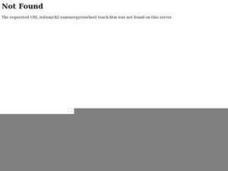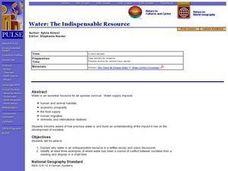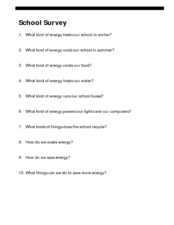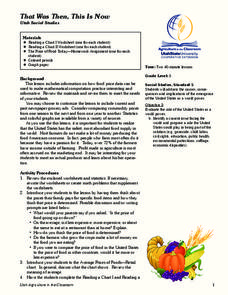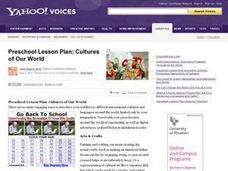Curated OER
Solar Matters
Students design an energy resource wheel and demonstrate how to use it to access information about renewable and nonrenewable energy sources.
Curated OER
World Geography: Water: The Indispensable Resource
Young scholars are able to explain why water is an indispensable resource in a written essay and class discussion. They identify at least three examples of where water has been a source of conflict between societies from a reading and...
Curated OER
Declaration of Independence
Eleventh graders interpret and analyze political cartoons. In this primary source analysis lesson, 11th graders examine the implications of Industrialization as they respond to questions regarding selected political cartoons about the...
Curated OER
School Survey
In this school energy worksheet, students read the questions about school's energy sources, the way school's can recycle, and how energy can be wasted or saved in schools.
Curated OER
Clues From the Past: Daily Life
Students discover the ways different cultures gathered and made food. In groups, they read excerpts from primary sources about the food people in Mesopotamia liked to eat. They work together to make a batch of goat stew and a loaf of bread.
Curated OER
Our Choices Matter: What You Eat
Students will record their food choices for one week, noting calories, protein and vitamin content of foods using a given USDA website. Students will discuss whole class the important of proper nutrition and its role, and what happens...
Curated OER
What's For Dinner?
Students explore the food chain. They brainstorm and create a consumer-consumed food chains using magazine pictures and research materials. Students identify consumer-consumed relationships.
Curated OER
Lower the Trans and Increase the Omega-3s
Students identify the health risks associated with trans fats. In this adult health lesson, students examine food labels for hydrogenated oils content. They discuss the benefits and sources of omega-3s.
Curated OER
Secrets of the Ocean Realm - Survival in the Sea
Students determine the sequential links in a marine food chain and identify the roles that various organisms play in this chain. Students develop charts as visual aids for illustrating marine food chains.
Curated OER
That was Then, This is Now
Students compare and contrast data charts and statistics for food prices of now and in the past. In this food prices lesson plan, students answer short answer questions and calculate computations.
Curated OER
The Annotated Bibliography
Students put sources into correct Modern Language Association (MLA)bibliographic format, and evaluate accuracy of information and research value of two articles through short written annotated bibliography for each.
Curated OER
Do the Research! (Different Trivia Questions)
For this research worksheet, students use books or the Internet to find the answers to 9 questions. After writing the answer, students list the source used.
Curated OER
Introduction to Digestion: What Happens to a Hamburger?
Students explore the human body by analyzing how food is absorbed. In this food digestion lesson plan, students utilize health vocabulary terms by participating in a guessing game activity. Students discuss their own eating habits and...
Curated OER
Did Somebody Say...? Where to Work?
Students conduct research on four fast food restaurants to determine where they might apply for a job. They conduct research on hourly rate, working conditions, and benefits, construct a spreadsheet with a graph, and present their...
Curated OER
Biomass: The Energy of the Future
Students research renewable fuels. In this alternative energy instructional activity, students compile information and create a comparison chart on renewable resources. This instructional activity includes additional suggested readings,...
Curated OER
Grand Grocery Graphs
Learners experience creating their own graphs on graph paper and the computer program "Graph Club." They approach this task by utilizing food as their primary source for the activities. In addition, they interact with their peers as they...
Curated OER
Cultures of Our World
Students eat food, make crafts, read books, and wear costumes all to learn about another culture. In this culture lesson plan, students can also go to a museum.
Curated OER
Carnivorous Plants
Young scholars examine how carnivorous plants get their nutrients from animals. In this food web lesson students examine how the plants attract their prey and are given many onilne sources to research.
Curated OER
Cruciferous Crusaders Crossword Puzzle
In this healthy foods worksheet, students solve a 10 word crossword puzzle where the words are related to leafy green vegetables. A word list is provided.
Curated OER
Where Did My Lunch Come From? A U.S. Regional Tour
Students explore the regions from which their food comes. In this social studies lesson, students identify the different agricultural products that are found in the major regions of the United States. Students create a lunch menu.
Curated OER
Building a Pill Bug Palace
Students make "pets" of isopods (potato bugs) to determine their preferred environment and food sources. They record their results on a bar graph and in a scientific report.
Curated OER
Milkweed Plants
Second graders view milkweed plants (or pictures). The describe the plant and discuss ways some butterflies use it as a food source. Students view four pictures of different phases of a milkweed plant's life cycle. They discuss the...
Curated OER
Oklahoma's Roots and Leafy Greens
Learners explore valuable food sources. They examine vegetable that have roots and leafy greens that we eat. They also discuss the various used for the leafy greens of vegetable plants. Students create a carrot necklace using carrot slices.
Curated OER
Rainforest- Online Worksheet
In this online rainforests worksheet, students use the links to research the answers to 16 questions. They determine facts about the locations, types, animal inhabitants, and food sources that are associated with rainforests.


